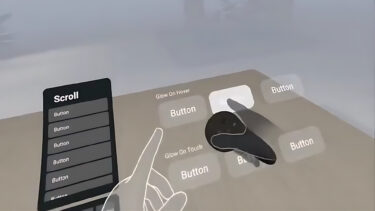Virtual Desktop: Update enables Quest hand tracking on PC via VDXR

A new update for Virtual Desktop brings hand, body, face and eye tracking from Quest VR headsets to PC.
With version 1.30.0 it is now possible to send face and eye tracking data (Quest Pro only) as well as body and hand tracking data from Quest VR headsets to the PC via VDXR. However, to enable hand tracking in PC VR games, developers will need to implement the required OpenXR extension in their games. In addition, Virtual Desktop now supports tongue tracking and VR ports from Team Beef, which will now appear in the Games tab.
Update v1.30 is live! It adds an option to forward face/hand/eye/body tracking to the PC so that PCVR games can use those through VDXR. It also adds tongue tracking, new music tracks and a bunch of other improvements. Enjoy!
— Guy Godin (@VRDesktop) January 30, 2024
Further new features in update version 1.30.0:
- Icon added to the performance overlay when encrypted traffic is used
- Added render resolution percentage and max bitrate to Performance Overlay
- New music tracks added
- Screenshot folder location can now be changed ("Media" tab in streamer window)
- App now stays in passthrough mode while loading on Quest
- Improved support for ultrawide monitors
- The driver for virtual monitors now supports up to 4k @ 120 (previously 2560 × 1440)
- Disconnections when downloading videos are now prevented
- Hand gestures for trigger and grip have been re-added when using hand tracking in VR games
- GPU memory leak on the PC side fixed
- Fixed slow decoding when using AMD 6450 and 6550 graphics cards
- Fixed 32-bit compatibility issue with some VR games
- Fixed compatibility issues with VR games: Tetris Effect, Premium Bowling, Battle Talent, Paradiddle
- VR game Hubris now uses VDXR by default
- Fixed controller offsets with VDXR in Ghosts of Tabor and Contractors VR
The full list of patch notes can be found on the Virtual Desktop Discord server.
VDXR improves performance of PC VR games
VirtualDesktopXR (VDXR) is an official part of Virtual Desktop since an update in November. The optimized runtime saves processing power, which benefits the performance of PC VR games based on the OpenXR standard.
If the announced support for tongue tracking will make you shake your head in disbelief: The Quest Pro has been able to detect tongue movements via face tracking since a software update. However, the headset only detects how far the tongue is extended. For more precise tongue tracking, external modules such as HTC's Full Face Tracker are required.
Note: Links to online stores in articles can be so-called affiliate links. If you buy through this link, MIXED receives a commission from the provider. For you the price does not change.